Asked to name his best-ever West Indies squad, Lloyd Best named as his very first selectee the dean of West Indian cricket writers, Tony Cozier. This was in the late 1990s; we did not yet know that, like the Israelites in the Old Testament, we West Indians would be condemned to wander through Test cricket’s desert for 40-plus years. Or more.
In fact, if Best’s premise is solid, given what passes for cricket reporting in today’s local and regional media, Armageddon may well be upon us before Windies even come close to seeing cricket’s Promised Land again.

(Copyright AFP 2017/Prakash Singh)
Of course, despite languishing near the bottom of the rankings in all three of cricket’s current formats, the Windies are the current world champions in the shortest format, the T20’s. But, as Dwayne Bravo pointed out in Wired868’s latest Cover Drive interview, precious few of the players who helped the regional side to re-capture that title in 2016 will be in the reckoning when the time comes for Windies to defend it in Australia in late 2020.
So those who prefer to see the full half of the glass will probably be made rudely aware of their non-20/20 vision.
The empty half of the glass, however, is my immediate concern: Windies are losing rather than gaining ground. As the other Best implies, the quality of the reporting during the glory days has been at least partially responsible for West Indian cricketing success. But, no one has really emerged to step into Cozier’s large shoes since his passing although it has to be admitted that, in the longer formats anyway, there has not been too much to report.
[dfp-ad]And even in the shorter format where Windies still have something of a presence, the reporting has been found wanting.
Espncricinfo recently announced that “Twenty20 needs a more evolved and a more nuanced system, (…) a new stats language. They propose, the story points out, to produce some completely different data metrics to more accurately encapsulate the T20 essence:
“… while the game has evolved continuously, and more rapidly than ever before in the last decade, the tools for measuring performances have lagged behind. (…) The traditional measurements—averages, strike rates, and economy rates—don’t always make sense.”

The proposed new categories will enable us to assess not just the strike rate of a batsman like Andre Russell but his Smart Strike Rate, which “takes into account the overall scoring patterns in the game, and during the period when the batsman was at the crease.”
Dwayne Bravo’s Smart Runs Index will be “calculated based on the strike rate of other batsmen in the entire match, and the strike rate at the other end while the batsman was at the crease.”
Similarly, Sunil Narine’s Smart Economy Rate will reflect his “economy rate after taking into account the rate of other bowlers in the match, and also the phase of the game when he bowled (Powerplays, middle overs, death overs), thus giving “due consideration (…) to bowlers who bowl the tough overs—the last five/Powerplays.”
Mohammad Irfan’s skill will come into sharper focus because of the Dot Pressure Index, “a simple metric that rewards bowlers for bowling consecutive dots in an over—one point for three dots in a row, 1.33 for four, 1.66 for five, and two points for a maiden over” and Shimron Hetmyer’s real contribution to the Guyana Amazon’s successful 2018 season will be better appreciated owing to the self-explanatory Strike rate in first 5/10 balls.
None of this is, I daresay, especially insightful. It’s mere pragmatism, unsurprisingly perceived by people who really understand what they see happening on the field during a T20 game; it’s coming, after all, from ESPN.

(Courtesy Sean Morrison/Wired868)
Anyone spending ten minutes attentive to an NFL, NBA, NHL or MLB American TV broadcast will be inundated with incredible quantities of sometimes arcane stats designed to help elucidate individual and team performance and provide serious context for the battle taking place on the screen.
So I think it’s fair to ask whether you perhaps see a 21st Century Tony Cozier beginning to make his presence felt in today’s cricketing media.
How many of our cricket writers would you include in the group of “people who really understand what they see happening on the field during a T20 game”? How many of the local and regional television and/or radio commentators?
Do you get in the local and regional reports on the CPL, say, answers to all six of the essential reporting questions: What? Who? When? Where? Why? and How?
How often has the reporting identified for you the turning point, the critical moment at which the eventual outcome was decided?

(Copyright FoxSportsAfrica)
Now I do not for one moment underestimate the difficulty of capturing in a comparatively brief match report the wealth of information provided by the proposed new categories. But do you get the impression that our regional writers are even reaching for it? That they are aware of the subtleties and nuances inherent in the T20 challenge and obvious from the definition of the proposed new categories?
Does the reporting suggest to you that they are even mindful that “the traditional measurements—averages, strike rates, and economy rates—don’t always make sense,” that they do not tell the essential story? The truth is that many match reports fail to even identify the opposing captains.
I, therefore, have no hesitation in responding emphatically in the negative on all counts. And I want to suggest that if Windies are to stop turning the corner our cricket has been turning for the last two decades or even have a chance to keep heads above water in the T20 format, the quality of the reporting must improve.
Failing that, we can completely forget about winning more than the occasional T20 match against Afghanistan, Bangladesh, Ireland, Scotland and Zimbabwe…
…and, with luck, Sri Lanka.
Earl Best taught cricket, French, football and Spanish at QRC for many years and has written consistently for the Tapia and the Trinidad and Tobago Review since the 1970’s.
He is also a former sports editor at the Trinidad Guardian and the Trinidad Express and is now a senior lecturer in Journalism at COSTAATT.
 Wired868 Wired868 for smart sport news and opinion
Wired868 Wired868 for smart sport news and opinion






